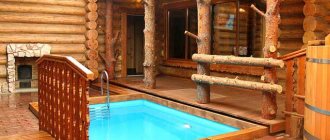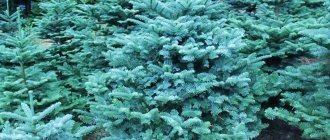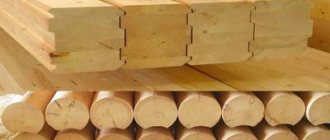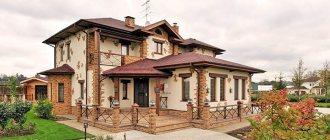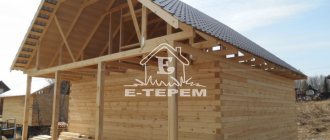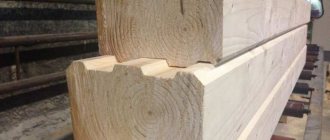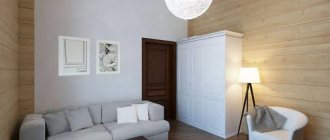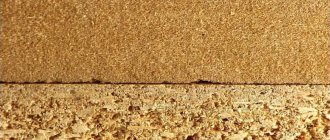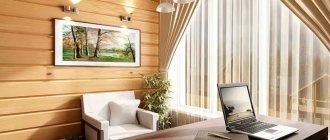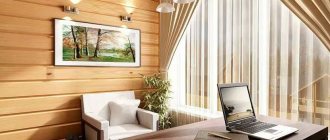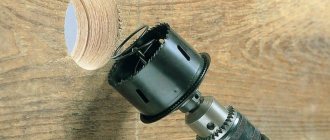The rhythm of modern life is accelerating. Due to increased stress, people are increasingly thinking about the resources of their body and are more actively looking for ways to restore wasted energy. Therefore, the trend for everything natural and environmentally friendly (food, clothing, lifestyle) is gaining momentum.
Eco-friendly housing is also no exception. Wooden houses are in fashion today. Indeed, unlike reinforced concrete buildings, they “breathe”, create a favorable microclimate around a person and have a beneficial effect on physical condition and emotional state.
Today wood occupies more than 40% of the individual housing construction segment. Its share is growing. A quarter of these residential buildings are constructed from timber. At the same time, the modern construction industry offers customers several options for such raw materials:
- glued (the most technologically advanced product obtained from individual lamellas)
- profiled (lumber from the inner part of wood, the upper and lower sides of which are made in the tongue-and-groove system)
- solid (a log processed on four sides to give it a square shape).
All of them have a geometrically accurate profile, allow for precise joining of parts and a smooth wall surface, and are easy to assemble. The first two are also visually very similar.
But despite this, they have a number of significant differences. In order to understand which timber, glued or profiled, is more suitable for you, let's compare their main parameters.
Manufacturing
The first is made from individual boards (lamellas) by gluing them with environmentally friendly compounds. Next, this “semi-finished product” is dried, pressed, and treated with antiseptics. As a result, it acquires enhanced technological characteristics. The raw material most often is coniferous wood (spruce, pine). But it is also possible to use species with premium characteristics (cedar, larch, oak).
Profiled timber is made from solid wood (mainly coniferous trees). Thanks to processing and milling, it is given a certain profile. Therefore, it is extremely important that it is produced on modern high-precision equipment. Its dimensions are determined by the size of the harvested trees.
In both cases, the quality of the original wood is of equal importance for the quality of the final product.
“Cheap and cheerful” - timber with natural humidity
Among its positive qualities, manufacturers usually note its complete environmental friendliness - it contains only wood and nothing else. And buyers prefer the material for its low cost, most often in the case of a small budget for all construction work.
After assembling a log house from such timber, you need to give it time to dry. This process is called shrinkage for a small loss of centimeters in the height of the walls. Drying wood is a mandatory process; if you do not wait and finish it ahead of schedule, extremely serious consequences will arise:
- deformation of vertical finishing elements;
- distortions and curvature of the skin outside and inside;
- deformation of door frames, jamming of doors in them;
- deformation of window blocks up to glass cracking.
Shrinkage processes can take from several months to 15-3 years, depending on weather conditions, the cross-section of lumber, and the type of wood from which the timber was made.
It is worth noting that log houses made of this type of building material will most likely require finishing, both inside and outside. The reason for this is the inevitable appearance of cracks due to uneven drying, and it is difficult to achieve correct processes under normal conditions.
However, if you are not afraid of the need to take a break from construction, but have a desire to save money, you can choose this type of lumber.
Strength and tendency to deformation
In this indicator, glued laminated timber is superior to profiled timber. After all, it acquires additional strength when gluing and pressing.
In addition, during the production process its humidity drops to 11-14%. Therefore, it practically does not dry out and does not shrink (no more than 1-2%). This building material is very stable and practically not subject to deformation. Therefore, you can move into such a house immediately after all work is completed.
Profiled timber is inferior in strength. It is made from the inner part of the tree, which is looser and therefore less durable compared to the outer part. In addition, in production it is often not dried and therefore retains its natural moisture. Shrinkage and shrinkage occurs already in the log house. This will take at least a year.
Additionally, this is associated with increased risks of uncontrolled changes in the geometry of the structure. There are known cases when houses made of profiled timber swell, sag and warp.
How to save money when purchasing
Technical buildings are often built from high-quality timber, for example, commercial buildings in markets. Over the years of use, the timber becomes even drier and stronger. In many cities, such buildings are demolished and dismantled every month.
Stop by for demolition of buildings like this. You can buy quality material there at a very low price.
Whether to use this trick or not is up to everyone. But you can really find old material for a ridiculous price and build a small house with a budget of up to 100 thousand rubles.
And if you think that you cannot afford to build a house due to lack of money, then this issue can be resolved by approaching the issue of using old building material wisely.
Design features
When building a house from timber, customers often believe that only its thickness matters. It seems to them that the thicker the walls are, the warmer the house will be. This is only partly true. A major role in the issue of combating heat loss is played by the profile of the timber and its cross-sectional shape.
Alkor offers its customers laminated veneer lumber with an Austrian (German) profile, the so-called “comb”.
Its main advantages are high precision of material processing and clear geometric parameters. Fine-toothed cutting of the profile provides ideal protection against blowing without the use of a special seal and additional insulation: the shape of the teeth guarantees a tight fit and does not allow cold air to pass through.
The warmth in a house made of profiled timber depends, first of all, on the thickness of the material. Consequently, its consumption may be large or installation of thermal insulation from the inside and outside will be required. A house made of profiled timber without insulation is subject to higher heat loss. You will have to pay more for its heating.
In addition, a solid wood profile is more susceptible to swelling. Such timber cannot be collected in bad weather and stored in the open air without covering.
Video description
For possible mistakes when building a house from laminated veneer lumber and tips on how to avoid them, see the following video:
Durability and construction costs
Everyone who builds a house would like it to last a long time - at least a hundred years, and the costs would not exceed the allotted budget. Unfortunately, miracles do not happen. If you choose edged timber for the walls, you save significantly at the first stage of construction, but at the same time you doom yourself to additional expenses and limit the service life of the building. It is believed that a house made of ordinary timber will last 50 years, but for profiled timber, and especially glued timber, these periods increase significantly - 100 and 150 years, respectively.
It turns out that the difference in the price of building materials is directly proportional to their service life. Yes, profiled and laminated timber will cost more, but you will be able to move into a new home faster, and it will last you much longer.
Final comparison table
To clearly put everything into perspective, the main features of various types of timber are collected in a comparative table:
| Options | Regular and profiled timber | Glued laminated timber |
| Time frame for building a house | Easy to buy, quick to build, but then required to wait 10-12 months before continuing with finishing work. | The ideal geometry of the timber allows you to quickly put the house together like a puzzle. You can begin interior finishing almost immediately. |
| Appearance of walls and the need for additional exterior finishing | Cracks appear on the timber; the cracks must be caulked or sealed with sealant. Often you have to use insulation and finish the outside of the house. | Factory processing of wood and gluing of lamellas make the timber resistant to external influences. No additional finishing is required - it retains its impeccable appearance. |
| Shrinkage and cracking | Significant: from 3-5% for kiln-dried timber to 8% for lumber with natural moisture. | No more than 0.4 -1%. |
| The appearance of fungus and pest damage | It is possible that since moisture penetrates into the cracks, insulation and protection are not enough unless additional measures are taken. | The slats are impregnated with antiseptic and fire-fighting compounds at the factory. The timber is well protected, there are no pests. |
| Durability | Constant renewal of the protective layer is required. The service life does not exceed several decades. | Wall treatments are necessary, but they are carried out less frequently. The service life promised by the manufacturers is up to 150 years. |
| Impact on health and well-being | Environmentally friendly material, good for health. Coniferous wood and natural jute fibers are used for caulking. | There are doubts that low-quality adhesives and impregnations may be used. Vapor permeability and free air exchange in the house deteriorate. |
| Thermal insulation | Numerous cracks and cracks contribute to heat loss. The performance of profiled timber is slightly better. | The tongue-and-groove connection or comb prevents the penetration of cold air. The house is warmer, the walls can be made thinner. |
| Price category | The cost of the material is low, it is one of the most affordable. Kiln-drying profiled timber is somewhat more expensive | Glued laminated timber is several times more expensive than regular timber, but the cost of purchasing it is justified. You will save on finishing costs and will be able to move into your home much faster. |
Glued laminated timber or profiled timber: price
Glued laminated timber is approximately 1.8 times more expensive than profiled timber. This is also due to the peculiarities of production. It is more complex and technologically advanced, consisting of more stages.
However, here it is necessary to clearly understand that the final price of construction will depend not only on the price per cubic meter of material. Thus, facades made of laminated veneer lumber, unlike their counterparts, do not require further cladding. And in a house made of profiled timber during operation, constant thorough care of the wood is necessary so that it remains in good condition.
In addition, the cost of constructing walls is usually only about 15% of the cost of the entire project.
Therefore, the final cost of buildings made from these materials will be quite comparable.
The process of manufacturing different types of timber. Characteristic features of the resulting materials
To understand which timber is best for building a house, it first makes sense to familiarize yourself with the process of manufacturing laminated veneer lumber and solid wood products.
Massive timber
A massive beam, that is, made from a whole log, is obtained using the technology of cutting it (edging) - cutting off the peripheral areas from the round timber and giving it a square or rectangular shape in cross-section. The cost of such products is incomparably lower than glued ones.
It is important to remember that very often such lumber has the natural moisture content of natural wood, since it is made from unprepared wood. We must not forget that if such material is used to build a house without first drying it in properly created conditions, then the timber may behave unpredictably during the period of operation of the building. That is, the wood sometimes begins to deform, the timber can seriously crack or shrink significantly, which will lead to the appearance of quite large gaps between the wall parts.
The cheapest and “riskiest” option for construction is massive non-profiled timber, which is often made from wood that is not completely dried.
These factors do not stop many future home owners, and solid timber is quite often chosen as the main material for construction. But still, one should not completely ignore the deformation “inclinations” of such wood.
Massive profiled timber - as a rule, well-dried wood is already used for its manufacture
Massive profiled timber is made from prepared material, that is, the moisture content of the original wood is brought to the required level. Profiled timber differs from ordinary timber in the presence of grooves and tenons of the appropriate configuration, with the help of which the parts are connected to each other during the assembly of the walls of the house.
Natural profiled timber can be divided into two types according to humidity indicators:
- Natural humidity, which can be 18÷23%. Timber that has not been dried in a special chamber shrinks up to 10÷15% over a year. Wet wood does not absorb impregnations and paints and varnishes well, and when it dries naturally, the paint may begin to peel off from the surface of the finished walls. In addition, wet wood is more difficult to process, so a perfectly smooth surface, if necessary, is very difficult to achieve.
If a house is built from building materials that have not been kiln-dried, then it is usually left over the winter to allow the moisture to freeze out and the wood to dry naturally. Therefore, interior and exterior finishing, and, of course, moving in of the owners, are carried out only a few months after the construction of the house.
Construction of a house from profiled massive timber.
- Dry timber that has been processed in a special drying chamber. Its humidity is usually maintained within 12÷18%. Timber dried using this technology is significantly more expensive than wet timber, as it has higher stability in operation. In addition, it is less susceptible to mold or mildew. It is also important that during storage of such material, the grooves and tenons do not change their linear parameters, that is, they will not cause problems during the installation of the walls of the building.
The shrinkage of dried timber after building a house is insignificant. Thus, over a year of operation, the material shrinks by only 1÷2%.
Expert opinion: Afanasyev E.V.
Chief editor of the Stroyday.ru project. Engineer.
The parameters of natural timber are determined by GOST standards. The standard length of parts is 3000 and 6000 mm, and the width and height in section can vary from 100 to 250 mm. It should be noted that sometimes manufacturers make timber to order, with a cross-section up to 300 mm. However, the cost of such non-standard materials will be significantly higher, and it’s not just a matter of greater volume. It’s just that for their manufacture it will be much more difficult to select logs of suitable diameter.
In regions of the country with low winter temperatures (and this probably includes most of the territory of Russia), it is recommended to choose timber with cross-sectional dimensions of 200×200 or 200×250 mm for external walls. The material, having cross-sectional dimensions of 100×100 or 100×120 mm, is usually used for installing internal interior partitions.
Massive timber has both pronounced advantages and serious disadvantages. One of the “cons” is the appearance of deep cracks.
Solid timber, when compared with laminated timber, has its advantages and disadvantages. At first glance, it may seem that he has much fewer positive qualities than negative ones. However, its perhaps few “advantages” are quite significant arguments that are quite capable of becoming decisive when choosing a building material.
So, the advantages of massive timber include the following points:
- Solid timber is more common in private construction due to its affordability compared to the laminated veneer lumber. This factor can be considered one of the most convincing “advantages” of the material.
- Another important advantage of this building material is its absolute environmental friendliness. No additional artificially created compounds are used in its production.
- Profiled solid timber, which has high-quality processing, has an aesthetic appearance, and therefore often does not require additional external finishing.
- Natural wood has a “breathing” effect.
- When using natural insulation in combination with natural wood, the healthiest microclimate is created in the house.
The disadvantages of solid wood timber include the following:
- There are great difficulties in producing timber with a large cross-section, since tree trunks have natural defects, which the manufacturer tries to remove when processing the logs. These can be large knots, bends, branches of trunks, affected areas, etc.
- Natural wood also has some hidden disadvantages, which are often discovered during the process of building a house.
- Possible appearance of cracks under the influence of external factors - precipitation, temperature changes, sunlight, wind. The possibility of wood deformation can never be completely ruled out.
Glued laminated timber
The technology for manufacturing laminated veneer lumber is more complex and expensive, as it includes several stages, which require a lot of time.
Glued products are a multilayer material consisting of several massive boards of different or equal thickness. For the production of laminated veneer lumber, as a rule, coniferous wood is used.
Work on their production of multilayer laminated building materials from natural wood takes place approximately in the following order:
- The first stage is the selection and sorting of wood.
- Next, the logs are cut into boards of the required thickness.
The material for the manufacture of laminated veneer lumber is selected boards, which after appropriate processing will become lamellas
Prices for laminated veneer lumber
laminated veneer lumber
- After the initial screening, the boards are sent to special drying chambers, where excess moisture is removed from the wood. With this technology, only 10% humidity is considered normal. The permissible deviation from the set parameter can be no more than 2%. The humidity level is checked using a special device - a moisture meter.
The process of bringing the original wood to the required moisture level is carried out in special drying chambers.
- If the output board turns out to be under-dried or over-dried, then, depending on the humidity level, the material can be sent for conditioning or for drying.
- The board that successfully passes the moisture test is sent for a final inspection for flaws. If serious flaws are discovered, then either they are eliminated as far as possible, or such material is not allowed for further work.
- Further, the thinnest boards can be “stitched” together using the “groove-tenon” method, the depth of which is approximately 3÷5 mm. As a result of this process, prefabricated lamellas are formed - timber will be assembled from them and solid boards in the future.
The boards from which the lamellas are made are folded together before gluing them so that the fibers of each of them are directed in the opposite direction. This technique for composing glued parts helps in the future to avoid processes of deformation of finished products - mutual compensation of possible bends of the layers occurs.
The key to the quality of the material and its resistance to deformation is the correct arrangement of the lamellas that make up the laminated veneer lumber
- The surfaces of the resulting lamellas are carefully leveled using special equipment.
- At the next stage, the wood is sent for gluing. This process is carried out on glue-filling machines, where the required composition is applied to the workpieces. The glue used to fasten the lamellas is selected taking into account the strict environmental requirements for the safety of the material. Glued laminated timber must be a “clean” material that does not contain formaldehyde resins, as well as heavy metals and other substances harmful to humans and the environment.
- After applying glue to the lamellas, they are collected in a bag and transported to the pressing workshop. The number of lamellas that make up a laminated veneer lumber can vary from two to ten or even more, depending on the size of the workpieces and the planned size of the final product. Pressing is carried out in a horizontal mechanical press when the products are exposed to high pressure, and in compliance with a certain temperature and humidity regime.
The glue-coated workpieces, collected in bags, are sent to a pressing unit for drying.
In the pressing unit, the bags assembled from lamellas remain until the glue dries completely.
- Next, the glued packages undergo final processing, during which the profiled timber is given the specified geometric shapes and, as they say, a marketable appearance.
This is not a beam yet, but just a package glued together from lamellas.
It still has to undergo final processing - precise profiling and trimming. Depending on what shape is planned to be obtained at the output, various processing equipment is used at this stage. The processing process includes gouging to give precise cross-sectional dimensions, bowl cutting, profiling, and trimming on a special machine.
- The technological process is completed with the stage of treating laminated timber with antiseptic agents and fire retardants. This work is often done manually - a protective composition is applied to the surface of the timber using a soft brush. After this, to achieve the desired results, the products must be kept for 24 hours for the protective impregnation to dry out in the atmosphere. Only after this the timber can be used to build a house.
Using this technology, two types of timber are produced - load-bearing and enclosing. Load-bearing products are used to install house floors, and enclosing products are used to build walls.
Prices for edged timber
edged timber
Fencing profiled laminated timber - used for the construction of external walls and internal partitions of the building
In some cases, the supporting beam is reinforced with metal or fiberglass reinforcement, which is glued into the middle of the product during its manufacture. The fencing beam does not require a reinforcing insert.
A few words need to be said about the characteristic features of this type of building material.
Glued laminated timber has been used in the construction of houses relatively recently, or rather, no more than 25–30 years. But during this period, the material has already managed to prove its ease of use and durability after many years of use in the harshest conditions. Thanks to thoughtful manufacturing technology, a durable and practical material is obtained. You can move into a house built from it immediately after construction, that is, there is no need to give a pause for several months, waiting for the structure to shrink.
The illustration shows only a small selection of sections and sizes of profiled laminated veneer lumber
The dimensions of laminated veneer lumber can be completely different, since they are not limited by the diameter and length of the log from which the massive building material is made. Thus, the length of laminated veneer lumber can reach up to 18,000 mm, in contrast to massive timber, the standard length limit of which is 6,000 mm. In principle, there are no obstacles in assembling packages of any reasonable thickness and cross-sectional height.
However, laminated veneer lumber, despite its excellent characteristics, has not only positive, but also negative aspects.
The advantages of laminated veneer lumber include the following characteristic features:
- The material has a very precise geometry. And the dimensions of the parts “do not dance,” that is, they remain unchanged, even during long-term operation of the structure.
- The calibrated shapes of profiled laminated veneer lumber greatly simplify the process of building a house.
- Minimal shrinkage of the material allows you to move into the house immediately after its construction, and also not to postpone finishing work “for later”.
- Thanks to high-tech processing and impregnation with antiseptic agents, laminated timber perfectly resists any type of biological damage (mold, fungi, mosses, insects, etc.)
- During the operation of the house, the material does not lose its original aesthetic appearance.
- High-quality processed timber surfaces that are not prone to deformation minimize the cost of finishing external and internal walls.
The disadvantages of this material include the following:
- It is still difficult to talk about the realistically possible durability of the material, the duration of trouble-free operation of buildings constructed from it. The reason is trivial - the material began to be actively used only about 30 years ago, and this period is so far limited to the conclusions drawn. But, at the same time, very favorable trends are being observed in this matter.
- The high cost of the material, which makes laminated veneer lumber unavailable for widespread use.
- When making this type of timber, glue is used, which somewhat reduces the “purity” of the wood. There are no words, responsible manufacturers use adhesive compositions that are safe for humans and the environment, but nevertheless...
Environmental friendliness
Glued laminated timber is a building material made from two components. And if the environmental friendliness of wood is beyond doubt, the composition of the glue can negatively affect the quality of the final product.
Manufacturers of building materials use different types of glue (melamine, PVA-based, emulsion polymer isocyanate or EPI glue, polyurethane). Some of them contain synthetic resins and formaldehyde.
The safest and most environmentally friendly of them are EPI adhesives. They comply with strict European standards and regulations and do not contain formaldehyde, melamine, toluene, or volatile compounds. It is this Finnish-made glue that is used in the production of Alkor laminated timber.
To make sure that laminated veneer lumber is as environmentally friendly as possible, pay attention to such an interesting parameter as the holding time of the blanks in the press (pressing time). It shows how long the boards are under pressure from the press before being profiled. The peculiarities of production are such that immediately before gluing and subsequent mechanical processing, the timber must be kept in a warm room. Many production lines are moving away from EPI adhesives because they require longer curing times compared to their formaldehyde-containing counterparts. This entails the need to form accumulative buffers, a slight increase in the production cycle, and therefore an increase in costs. But in this way they reduce the environmental friendliness of the final product.
Therefore, in order to be completely confident in the environmental friendliness of the building material you purchase, be sure to ask the manufacturer what adhesive system was used in its production.
Profiled timber is closer to natural raw materials, as it is made from solid wood. It fully preserves all the unique properties of wood.
In this case, both materials are treated with special compounds that prevent rotting and fire.
How to buy quality timber?
One of the most important questions is how to purchase guaranteed quality materials for construction? After all, this will determine how warm the house will be, as well as the overall durability of the building.
A beam glued together from five lamellas.
So, today timber can be purchased on the construction market, or you can order it from a trusted manufacturer directly from a woodworking company.
Purchasing building materials on the market from an unverified seller is a very risky proposition. It is quite easy to be deceived and buy insufficiently high-quality material. Moreover, there are several common options for deceiving buyers.
- For example, glued or solid timber of a certain size is ordered, and, as a rule, the seller offers delivery of the material to the site. Upon delivery, it may turn out that the length or cross-section of the timber is slightly smaller than what was ordered. This means that the buyer has already overpaid the manufacturer a certain amount, regardless of the quality of the products. Therefore, it would be advisable to find out when and where the material will be loaded before delivery, so that you can come personally to check the quality of the products - take a tape measure and measure the timber.
- It is imperative to be present when loading the material for the reason that among the quality timber, an unscrupulous seller may well place defective products.
- To check the material for evenness, it is necessary to examine each product for bending in all planes, and immediately select the bent beam. It must be abandoned on the spot, as it will be extremely difficult to work with.
- In addition, it is necessary to inspect the products for uneven cuts and cuts, bark residues and insufficient grinding - all these flaws can be attributed to defects and require replacement of individual products. After all, you're spending your money and placing an order when you see quality samples, so demand the same quality for the entire batch you purchase.
The consequences of using insufficiently well-dried timber to build a house, which arose after the material shrinked.
- The most unpleasant moment may be the manufacturer’s dishonesty in indicating the percentage of wood moisture content, or in non-compliance with the technology for drying it. There are cases of using low-quality, cheapest glue in the production of laminated veneer lumber. If you use such material to build a house, then after a short time you may encounter problems when parts begin to come apart and bend.
- High-quality laminated veneer lumber consists of at least 5÷8 lamellas. Low-quality ones are assembled “quickly” from 3÷4 boards. Therefore, you need to pay special attention to this when purchasing.
The gluing of timber at the ends is the result of a violation or inadmissible simplification of production technology.
- If circumstances still force you to purchase laminated veneer lumber on the construction market, then you can conduct your own “examination” to determine the quality of the material. To do this, you need to ask to cut off a small section of the timber - if necessary, you can even buy it. The wood must then be weighed and the resulting value remembered or recorded. Next, the material must be boiled in water for two hours. Weighing will show what percentage of moisture the wood has absorbed. Then the fragment is dried to its original value (again, the recorded value of its mass will help to check). If after drying the cut returns to its original state, then the material is glued together with high quality. If the boards of the timber begin to come apart, it means that its production was carried out in violation of technological standards.
- You should not purchase timber packaged in plastic film without opening the packaging and checking its quality, as it is also often poorly processed or behaved poorly.
The optimal solution is to purchase high-quality timber directly from a manufacturer that has a high quality rating for its products.
The difference between the quality of timber ordered from a large manufacturer and purchased on the market is due to several important points, which include the following:
- Availability of normal conditions and necessary equipment for the production of quality products and for storing finished products.
- The presence of qualified specialists who manufacture products, carry out sorting and ensure proper control over their quality.
- Large specialized enterprises value their authority, and therefore not only produce high-quality products, but also try to organize careful shipment and delivery of them to the consumer.
It should be noted that in almost every region you can find a reputable manufacturer of both laminated veneer lumber and solid timber. Therefore, experts recommend turning to trusted manufacturers - only in this case you don’t have to worry about the quality of the material.
And, finally, a video filmed at the request of one of the leading Russian manufacturers of profiled timber -. It tells in detail, without embellishment, the secrets of choosing the right quality building material of this type.
Durability
Of all types of timber, laminated veneer lumber is considered the most durable, because thanks to the production technology it is free from the disadvantages of solid or profiled timber. It has high strength, moisture and frost resistance. The thermal conductivity of such raw materials is five times less than that of brick and thirteen times less than that of reinforced concrete. This means that the inside of such a dwelling will be drier and warmer.
It should not be forgotten that any wood is subject to the influence of negative external factors (humidity, temperature, ultraviolet radiation, insects, fungi, etc.), which can lead to the appearance of individual defects. Therefore, both the quality of installation and subsequent maintenance are important.
Humidity
Ordinary timber (also called natural moisture timber) is made from recently cut tree logs. Before starting work, such timber should be dried, otherwise the wood will begin to rot and may become covered with blue spots. In addition, reducing moisture will help avoid cracking of the structure and large shrinkage. It is necessary to lay the beam in a draft, avoiding contact.
According to technological standards, to obtain high-quality dry timber, it should be kept for 3 years in a hangar that is well ventilated in order to achieve optimal humidity (optimal wood humidity is 6 - 20%).
The components of laminated veneer lumber - lamellas - are dried in computerized dryers, due to which the procedure is strictly controlled. The drying period is 6 -9 days at a temperature of 50 - 65 degrees. The resulting humidity is guaranteed and does not exceed 12%, which means that shrinkage of buildings made from this building material is practically eliminated. The structure is little susceptible to rotting and deformation. According to experts, laminated veneer lumber is 30 percent stronger than regular timber, which guarantees a longer “life” of items made from it.
Safety
A house made of wood has two of the most dangerous enemies - wood-boring beetles and fire. Of course, the second one is much more dangerous, since it destroys the structure quickly. To protect yourself, it is wise to use heat-protective varnishes and treat the walls.
Glued laminated timber, already during manufacturing, is immediately treated both against pests and with fire retardants - substances that significantly increase resistance to fire. With the active influence of the salt solution contained in them, the smoldering process is inhibited and fire is prevented.
Ordinary timber should be additionally carefully treated with an antiseptic against uninvited guests, and then varnished.

